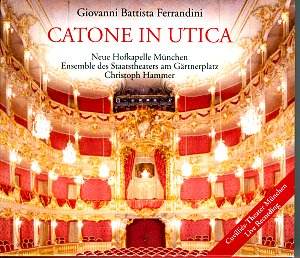When in 2003 the 250th anniversary of the Residenz-Theater
in Munich was to celebrated, it was decided to perform the same
opera which was performed at the opening of the theatre in 1753:
Catone in Utica by Giovanni Battista Ferrandini. That was a
bold decision, as Ferrandini is not exactly a household name
in our time. He isn't a completely unknown quantity, though;
his lamento 'Pianto di Madonna' was once attributed to Handel.
It is perhaps due to this misattribution that it was ever recorded.
That Ferrandini was elected to compose the opera for the
opening of the theatre in 1753 is less surprising. At that time
Ferrandini was a widely known and admired composer. During his
service at the court of Elector Karl Albrecht he was a key figure
in musical life. He was asked to write an opera to celebrate
the coronation of Karl Albrecht as emperor Karl VII in Frankfurt
in 1742.
He was also active as a voice teacher. One of his students
was the tenor Anton Raaff, who sang the title role in the first
performance of Mozart's Idomeneo. And he was the music teacher
of Max III Joseph - son of Karl Albrecht - who became Elector
in 1745, and who played the viola da gamba at a professional
level. He also taught Max III Joseph’s sister Antonia Walpurgis
who composed two operas. In 1771 Leopold and Wolfgang Mozart
visited him in Padua, where he was living at the time, another
indication of his high standing.
The libretto of Catone in Utica was written by Pietro Metastasio,
the most prolific writer of librettos in the 18th century. It
is based on historical facts. Although most of the characters
are real the story is fantasy, although the libretto itself
claims it as "probable". Julius Caesar succeeded in
being accepted as ruler for life of the Roman empire. His only
remaining opponent was the senator Cato the Younger, who was
universally respected and admired because of his high personal
values as well as his steadfast defendance of the Roman Republic.
Cato fled to Utica, where he tried to keep the values of the
Republic alive. When Caesar travels to Utica with his army to
break Cato's resistance, he was willing to compromise, out of
admiration for Cato. But the senator refused any compromise.
In his talks to Caesar, he asked the dictator to surrender and
to go to prison. This was totally unacceptable to Caesar. In
the end Cato was ready to fight against Caesar. Things got complicated
when he found out that his daughter Marzia had refused to marry
his ally Arbace, a Numidian prince, because she was still in
love with Caesar. Emilia (her real name was Cornelia, which
was changed to make it more singable), the widow of Pompeius
Magnus who had been killed by Caesar, developed a plan to take
revenge on him. Military action was inevitable, and the army
of Caesar easily broke any resistance from Utica. When Cato
found out, he took his own life. Caesar learnt of Cato's death
among the celebrations of his army: he faced the hatred of Marzia,
who blamed him for her father's death, and in shock threw his
crown of laurels to the ground.
The libretto is interesting in that it isn't black-and-white.
At first Cato seems to be the hero: he is the defender of the
Republic and its values against the absolute rule of a dictator.
But soon it turns out that his attitude is not that different
from Caesar's. Fulvio, envoy of the Roman Senate and ally of
Caesar, gives Cato a letter in which the Senate asks him to
give up his resistance in the interest of peace. When he discusses
the letter with Fulvio, he denies the Senate's rights to ask
him anything, as it has become "a debased herd of slaves"
and then adds: "Rome is everywhere where honour has not
yet been extinguished, where the love of freedom still exists;
my faithful are Rome, Rome am I." And when he finds out
that Marzia is in love with Caesar, he threatens to kill her.
Caesar, on the other hand, may be a dictator, who destroyed
the Republic and its values, but he shows an eagerness to compromise,
out of respect and even admiration for Cato's moral standing
and his tenacity in defending his views. And in the end, when
the military victory over Utica has been completed, he orders
his army to exercise moderation in respect to the vanquished.
The structure of the opera is rooted in the conventions
of the baroque, with a sequence of recitatives and da capo arias.
The difference with most baroque operas is that Ferrandini has
written down with great precision ornaments, appoggiaturas and
dynamics. It isn't quite clear from the booklet essay by Christoph
Hammer what is left to the interpreters, for instance in regard
to the cadences which are sung at the end of the arias. The
vocal scoring is noticeable: as in most baroque operas the high
voices are dominant, but here the title role is given to a tenor,
which was rather rare in baroque operas, and became much more
common in the second half of the 18th century.
This is a recording of a live performance, with all the
related merits and demerits. One the one hand there is a very
lively interaction between the protagonists, which is much harder
to realise in studio recordings. On the other hand there are
moments when there is no singing and playing, and one only hears
stage noises which suggest something dramatic happening - what
exactly is happening is left to the listener's imagination.
We get at least some help from the booklet, which contains some
pictures from the staging and short synopses of the action at
the start of every scene.
Another major disadvantage is that this production has
fallen victim to the habit of cutting parts of pre-classical
operas. Some arias have been cut, recitatives have been shortened,
and in some cases parts of the recitatives are spoken during
the orchestral introduction of the following aria. I am not
convinced that today's audiences are unable or unwilling to
listen to and watch a performance of a baroque opera which lasts
four hours or so. And when it is argued that some decisions,
like cuts or shifting arias from one place to another and even
from one character to another, are taken 'for dramatic reasons',
I wonder why modern interpreters think they know better than
the composer.
Considering the quality of Ferrandini's music, it is a
shame that Catone in Utica isn't recorded complete. It is hardly
to be expected that a complete recording will be made in the
foreseeable future. But we should be very thankful that we have
the opportunity to listen to this opera at all, in a performance
which by and large is very good. In particular Kobie van Rensburg
gives a moving and technically brilliant interpretation of the
title role. He is very much aware of the different sides of
Cato's character, and expresses them well. His opponent Caesar
isn't given a macho portrayal. It was a good decision to ask
the sopranist Robert Crowe to sing this role. He does so rather
well, although I sometimes find his voice a bit shrill and runs
and leaps aren't always technically perfect. Johnny Maldonado
gives a sensitive interpretation of the role of Arbace. He uses
his breast register to good effect in the aria 'Combattuta da
tante vicende'. Unfortunately his diction isn't always as clear
as it should be. Simone Schneider and Sandra Moon are convincing
as Marzia and Emilia respectively, as is Florian Simson in the
rather small role of Fulvio. The orchestra is excellent, colourful
and full of dynamic contrast.
Considering this is a live recording the sound engineer
has done a very good job. The booklet contains an essay by Christoph
Hammer about the composer, the opera and the interpretation.
It also sets out the libretto, with translations in German and
English. The parts which have been cut, have been left out.
A complete printing would have been preferable, as it would
have allowed the listener to read the story in its entirety
and it would have informed him about exactly which parts have
been cut.
To sum up: despite its minor shortcomings this is a very
interesting and recommendable release. I sincerely hope we shall
hear more of Ferrandini's oeuvre in the future.
Johan
van Veen

![]() Robert Crowe (Cesare), Sandra Moon (Emilia), Simone Schneider (Marzia),
soprano; Johnny Maldonado (Arbace), alto; Kobie van Rensburg (Catone),
Florian Simson (Fulvio), tenor
Robert Crowe (Cesare), Sandra Moon (Emilia), Simone Schneider (Marzia),
soprano; Johnny Maldonado (Arbace), alto; Kobie van Rensburg (Catone),
Florian Simson (Fulvio), tenor![]() OEHMS
CLASSICS OC 901 [3
CDs: 63:37 + 60:57 + 63:21]
OEHMS
CLASSICS OC 901 [3
CDs: 63:37 + 60:57 + 63:21]





